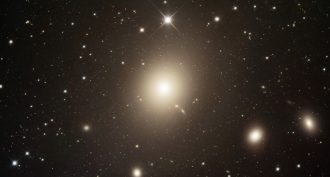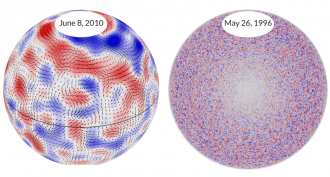Space

Educators and Parents, Sign Up for The Cheat Sheet
Weekly updates to help you use Science News Explores in the learning environment
Thank you for signing up!
There was a problem signing you up.
-
 Space
SpaceA ‘wedding ring’ in space
An unusually circular gas remnant of a dead star appears behind a star that’s still burning bright. When viewed from Earth, the pair resembles a sparkling diamond ring.
-
 Planets
PlanetsSurprising rings circle comet-asteroid hybrid
It’s too small to be a planet. Yet this planet wannabe still resembles Saturn-like giants. It’s the smallest solar system inhabitant to, like them, host rings of orbiting ice.
-
 Space
SpaceWaves from the birth of time
Inflation is the idea that in the split-second after the Big Bang, the universe exploded into huge-ness. Although the hypothesis is 30 years old, evidence to confirm it had been lacking. Until now.
-
 Space
SpaceGalaxy drags trail of newborn stars
Distant galaxy plows through cluster of others, with baby stars in tow
-
 Space
SpaceStar cluster rockets through space
It’s the first time astronomers have ever detected a cluster of stars moving collectively at such speed.
-
 Animals
AnimalsWe are stardust
Everything making up Earth and what’s now living upon it — from trees and people to our pets and their fleas — owes their origins to the elements forged by ancient stars.
By Beth Geiger -
 Planets
PlanetsNew evidence of a wet Mars
Ten years in to its tour of Mars, the Opportunity rover finds another place on the Red Planet that once might have hosted water.
-

-
 Space
SpaceGalaxies stash mass in clouds of gas
Astronomers may have finally figured out why predictions of the amount of matter in the universe don’t match observations. A huge amount may hide in the gas clouds that surround galaxies.
-
 Space
SpaceDusty remains from a dead star
A supernova first spotted in 1987 produced a huge cloud of space dust. Astronomers are now finding clues in it to how stars formed in the early universe.
-
 Space
SpaceThe sun’s giant heat elevators
Scientists have long known that plumes of hot plasma rise from the sun’s interior to its outer layers. New observations have now identified especially big plumes that can be 15 times as wide as Earth’s diameter and last for months.
-
 Planets
PlanetsJupiter’s long-lasting storm
Most studies of Jupiter’s centuries-old Great Red Spot suggest this giant storm should have petered out after a few decades. A new study traces the storm’s staying power to the vertical movement of its gases.